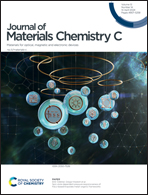Triplet formation inhibits amplified spontaneous emission in perylene-based polycyclic aromatic hydrocarbons†
Abstract
Polycyclic aromatic hydrocarbons (PAHs) have demonstrated potential as active laser materials, showing good amplified stimulated emission (ASE) properties. However, the molecular origin of their ASE properties is still unclear and depends on each particular compound. In this work we study the ASE properties of polystyrene films hosting three different perylene-based PAHs YZ–1, YZ–2 and YZ–3, where only YZ–3 has displayed ASE. Their molecular structure has been systematically changed to establish the connection between their molecular structure and their ASE properties. A complete spectroscopic study, with ground state and time-resolved techniques, show that, even at low yields, triplets play a critical role as a major loss mechanism. Triplet slow relaxation to the ground state completely hinders the required imbalance of the S1 and S0 states for successful ASE. Quantum chemical calculations suggest that a lower number of available triplet states for YZ–3 are responsible for the blockage in triplet formation and, therefore, do not restrict ASE. This work not only presents a new PAH showing ASE, but also unequivocally proves the massive importance of triplet states in the development of organic lasers.

- This article is part of the themed collection: Molecular scale electronics


 Please wait while we load your content...
Please wait while we load your content...